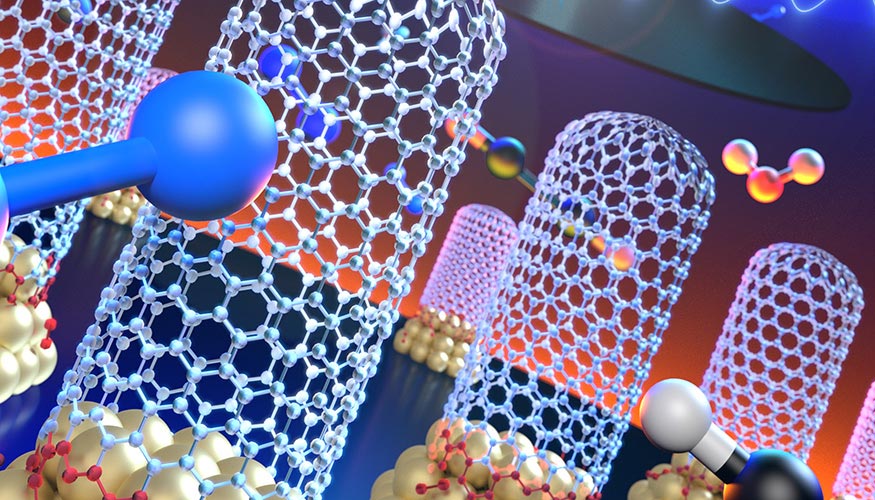
Vertically aligned carbon nanotubes developing from catalytic nanoparticles (gold shade) on a silicon wafer on major of a heating phase (red glow). Diffusion of acetylene (black molecules) through the fuel period to the catalytic web sites establishes the development rate in a cold-wall showerhead reactor. Credit history: Image by Adam Samuel Connell/LLNL
Scientists at the Office of Energy’s Lawrence Livermore Nationwide Laboratory (LLNL) are scaling up the production of vertically aligned solitary-walled carbon nanotubes (SWCNT). This amazing substance could revolutionize diverse professional products and solutions ranging from rechargeable batteries, sporting items, and automotive sections to boat hulls and water filters. The investigation was released a short while ago in the journal Carbon.
Most carbon nanotube (CNT) generation now is unorganized CNT architectures that is used in bulk composite materials and skinny films. Even so, for quite a few makes use of, arranged CNT architectures, like vertically aligned forests, deliver essential rewards for exploiting the houses of person CNTs in macroscopic techniques.
“Robust synthesis of vertically-aligned carbon nanotubes at massive scale is required to speed up deployment of many chopping-edge devices to rising professional applications,” explained LLNL scientist and guide author Francesco Fornasiero. “To address this have to have, we demonstrated that the structural qualities of single-walled CNTs developed at wafer scale in a progress regime dominated by bulk diffusion of the gaseous carbon precursor are remarkably invariant above a wide selection of process ailments.”
The team of researchers found out that the vertically oriented SWCNTs retained extremely superior high-quality when growing precursor concentration (the initial carbon) up to 30-fold, the catalyst substrate spot from 1 cm2 to 180 cm2, expansion tension from 20 to 790 Mbar and gas flowrates up to 8-fold.
LLNL researchers derived a kinetics product that demonstrates the advancement kinetics can be accelerated by applying a lighter bath gasoline to help precursor diffusion. In addition, byproduct formation, which will become progressively a lot more vital at greater development pressure, could be greatly mitigated by working with a hydrogen-absolutely free development setting. The product also indicates that manufacturing throughput could be amplified by 6-fold with carbon conversion effectiveness of larger than 90{ca2182fc8fed51dc37b95061ee48b5056cde1176732b225548c54a0c0156d303} with the proper selection of the CNT progress recipe and fluid dynamics circumstances.
“These product projections, together with the remarkably conserved composition of the CNT forests more than a vast variety of synthesis conditions, propose that a bulk-diffusion-confined development regime may aid preservation of vertically aligned CNT-centered gadget performance in the course of scale up,” claimed LLNL scientist and first creator Sei Jin Park.
The group concluded that operating in a development routine that is quantitatively described by a basic CNT progress kinetics model can facilitate process optimization and guide to a more immediate deployment of chopping-edge vertically-aligned CNT applications.
Programs include lithium-ion batteries, supercapacitors, drinking water purification, thermal interfaces, breathable fabrics, and sensors.
Reference: “Synthesis of wafer-scale SWCNT forests with remarkably invariant structural attributes in a bulk-diffusion-controlled kinetic regime” by Sei Jin Park, Kathleen Moyer-Vanderburgh, Steven F. Buchsbaum, Eric R. Meshot, Melinda L. Jue, Kuang Jen Wu and Francesco Fornasiero, 29 September 2022, Carbon.
DOI: 10.1016/j.carbon.2022.09.068
Other LLNL authors are Kathleen Moyer-Vanderburgh, Steven Buchsbaum, Eric Meshot, Melinda Jue and Kuang Jen Wu. The perform is funded by the Chemical and Organic Technologies Department of the Defense Risk Reduction Company.


More Stories
Understanding Mileage Blockers: Technology, Ethics, and the Road Ahead
GPS lap timer – how does it works?
Dana auto parts workers hold meeting series in Toledo to organize joint fight back with Jeep workers